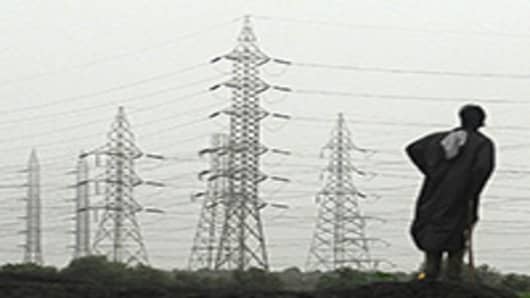While India has seen annual economic growth of 8 percent and an educated, cheap workforce, the blackout that swept the country at the end of July — and the underlying infrastructure problems it exposed — is a glaring threat to the country's economic expansion.
For two days 670 million people, roughly 10 percent of the world's population, were left in the dark.
The incident confirmed the worst fears of many business leaders, experts say. And it could lead them to reconsider plans to bring new operations into India.
"The power grid situation is very serious," said Persis Khambatta, Fellow, Wadhwani Chair in U.S.-India Policy Studies of the Center for Strategic and International Studies in Washington. "It's an impediment to investors in terms of doing business in India. If you're not sure your power source is reliable, you're going to have some second thoughts about doing business there."
India's troubles with its power grid go far beyond its inability to keep up with demand.
To put things in perspective: Due to inefficiencies and delivery issues, the U.S. power grid loses up to 10 percent of the electricity it produces. At the state-run Power Grid Corp. of India Ltd., that number is as high as 50 percent because of widespread theft and unauthorized usage, according to Massoud Amin, professor of electrical and computer engineering at the University of Minnesota and director of the Technological Leadership Institute.
Government officials say the country needs $1 trillion for infrastructure improvements by 2017 — and it's looking to the private sector to provide most of that. That's unlikely, though. The head of India's Planning Commission admitted as much in August. (More:How a Little Indian Bean Impacts US Fracking)
Even if it could meet that lofty goal, experts are skeptical the amount would be sufficient to cure the problem.
India's power troubles go beyond an insufficient grid and people tapping into the line. Due to the country's poverty levels, energy companies are forced to offer artificially low rates, set by the government, to many of its customers. That results in budget problems — and was a major reason Indian energy company Reliance Power delayed a $3.2 billion coal-fired project in the southern state of Andhra Pradesh.
Late last month, the Indian government (in an effort to relieve state-owned electricity distributors of their $35 billion debt overhang) passed a bailout package that restructured their short term loans — and took on 50 percent of the debt.
"Countries can be too large, making it difficult to get consensus. I would recommend having a national vision, but doing the work locally. It goes back to 'think globally, but act locally.' That vision is even more pertinent in this case."
Additionally, the underlying systems behind India's power grid are fast becoming antiquated. Amin points out that, like in the U.S., electricity in India is prioritized, with power diverted to regions that need more at any given moment. Currently, the monitoring systems check every 2 to 4 seconds. What's required, he said, is a system known as a phasor measurement unit, which checks as fast as every 50 milliseconds, creating a smarter grid. (More:10 Hot Indian Startups)
India, says Phillip F. Schewe, a specialist in electricity and author of the book "The Grid: A Journey Through the Heart of Our Electrified World," is in a place similar to where America was in the early 1990s — when partial privatization was beginning to roll out. (Private electric companies operate in the U.S., but the transportation of the power over the lines is still regulated.) That's giving some private companies pause.
"I don't know what sort of rate structure India could offer to make it worthwhile," said Schewe. "If a huge farmer was using electricity to, say, cultivate his fields, who can blame him for wanting cheap rates? He's not going to pay rates that make the local company break even, so why should, say, Westinghouse want to come in there. Where are these companies going to make money?"
Amin suggests that the key to fixing the problem likely lies in a public/private program that offers some overarching national guidelines, but lets pilot programs be run on a state-by-state basis. (More:Bollywood Goes Global)
"Countries can be too large, making it difficult to get consensus," he said. "I would recommend having a national vision, but doing the work locally. It goes back to 'think globally, but act locally.' That vision is even more pertinent in this case."
Whatever the solution, energy infrastructure problems are something India can no longer afford to postpone dealing with. While the country has seen strong growth recently, experts say that won't be possible for much longer, given the current situation.
"Keeping up that 8 percent clip is hard," said Khambatta. "It will reach a tipping point where we can't sustain that level of growth."
"Electricity," added Amin, "is the linchpin of economic growth."


